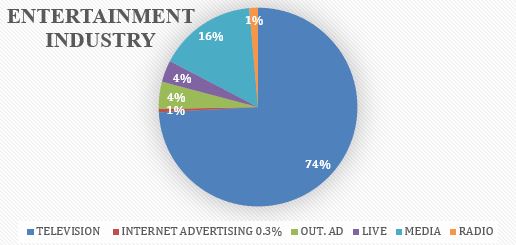![]()
Media is one of the most powerful sectors of an economy. It refers to the communication channel to carry news, music, movies, education, promotional messages, and other data to the targeted audience. Inform and entertain are the two core objectives of media. Information driven media and entertainment media are different. Information tends to be actionable and therefore something more valuable, on the other hand, the entertainment industry includes every form of activity that holds the interest of an audience or gives satisfaction and joy.
Introduction:
The Indian Media and Entertainment (M&E) industry is the major contributing sector for the economy. The industry is predicted to grow at a much faster rate than the global average rate. This sector witnessed consistent innovative technology trends and also increases in digitalization and internet usage by the customer and content supplier. In 2019 this sector reached Rs 1.82 trillion (US$25.7 billion) a growth of 9 % over 2018 and expected to cross Rs 2.4 trillion (US$34 billion) by 2022, at a CAGR of 10% as stated by FICCI and EY, however, it has clarified that the findings of this report had not taken into consideration the rapidly evolving impact of Covid-19 on the industry.
Cinema, television, radio, theatre, music, live shows, and fashion are the subs devoted to the entertainment industry. The media and entertainment industry can be broadly be categorized as follows:
- Print-magazines
- Broadcasting-television, radio, cinema
- Internet and other unconventional/modern-day media- websites, Ad buttons

Entertainment Media Laws in India
| Industry | Regulator |
| Cinema Industry | The Central Board of Film Certification |
| Television Industry | Cable TV Networks (Regulation) Act 1995 |
| Print Media | Press Council of India 1978 |
| Broadcasting | Telecom Regulatory Authority of India (TRAI) Prasar Bharati Act, 1990 |
| Sports | Ministry for Sports and Youth Affairs, Gol |
Additionally, there are number associations and legal bodies which are dealing with the entertainment industry like BCCI, IBF, MIB, and many more. Recalling them at one go which is a tougher task and one of the major drawback of the entertainment industry
Patent and Intellectual Property Rights (IPR) and Cyber Laws, in particular violation of copyrights, are one of the concerns in the entertainment industry. The Copyrights Act, 1957, the oldest IPR legislation in India, which provides for the copyright for the protection for literacy, dramatic, musical, sound recording, and any artistic work. The act was amended several times to meet national and international requirements. Patent under Patent Act, 1970, and the establishment of WTO and India also being a signatory to the Agreement on Trade-Related Aspects of Intellectual Property Rights (TRIPS) and legislations were come into the force for the protection of intellectual property rights.
Freedom of speech and expression is no doubt guaranteed by the Indian Constitution but Sedition and Defamatory action can always lead to both civil and criminal consequences under the Indian Penal Code.
As per Mergers & Acquisition law, the permission of MIB is required and censorship Laws are set out in the manner in which films are to be certified for exhibition in India.
Failure of Entertainment Industry
Instead of so many rules and regulations, laws, and legal bodies; the entertainment and media industry is facing many issues. Nepotism in the film industry, match-fixing in sports industry, copyrights, patents, licensing, and taxation continues to explode. The few examples of the failure of media and entertainment laws:
NaMo Tv, a channel run on all DTH platforms with the Prime Minister, Narender Modi’s picture as the brand logo. It was a “special service” broadcast channel and therefore didn’t acquire any license or permission from the government. This channel was launched at the beginning of the 2019 Lok Sabha elections and disappeared after elections. India is known to have as many as 350 unlicensed channels that come alive during elections.
‘Mr India’ rights dispute a witness to loopholes in Bollywood. Invisible man: in Mr. India, Shekhar Kapur gave India its first right popular celluloid superhero. The film’s original director Shekhar Kapur and lead actor Anil Kappor were unaware of the sale of remake rights. Such kinds of IPR cases are so common in the Indian film industry.
Nepotism-led ‘othering’ has reached a toxic level in Bollywood. Bollywood got ‘industry’ status in 1998 and the corporate studios got into the picture but scenario from them to now be the same and controlled by few families. The entry-level in the entertainment industry is still a challenge in this era of democracy. Suicide by Sushant Singh Rajput is the proof of this old Bollywood nepotism conspiracy theory.
Many films Like Padmaavat, Udta Punjab, Article 15 had to undergo many allegations and pleading. Besides dealing with the censorship filmmakers have to deal with the backlash of politics which often leads to court cases.
UK- based bookie Sanjeev Chawla was brought to India in February 2020 for the investigation for the biggest India-South Africa match-fixing scandal involving Hansie Cronje. No match is fair, all are fixed.
Need of Regulation
Corruption, Nepotism, Loot of people’s money, and terrorism which are the evil reality of our society, manage to exist despite of presence many laws. Making laws is not a solution; the problem is on the implication side. The first step in properly addressing the issues is to enforce the already existing laws sincerely. The entertainment industry needs one unified and transparent regulatory framework with less government control to bring consistency and fair competition. Foreign Direct Investment should be more liberal and taxation policy to be clearer. Industry should involve more paperwork to avoid IPR and patent issues. A clear and fair competitive guidelines framework should be there. The players involved in the scandal must be charged under Section 420 and 120 B of the Indian Penal Code.
Conclusion
Open and fair competition is the essence of democracy. This sunrise industry for the economy, employment generation, and global ratings need to be regulated. No doubt this pandemic has shaken up the media and entertainment industry more than any industry but at the same time advisory on the social distancing has lead to the increase in the consumption content on the other mediums like digital streaming platforms and other gaming platforms. In fact viewership across the several digital entertainment platforms has increased by 20%.



0 Comments